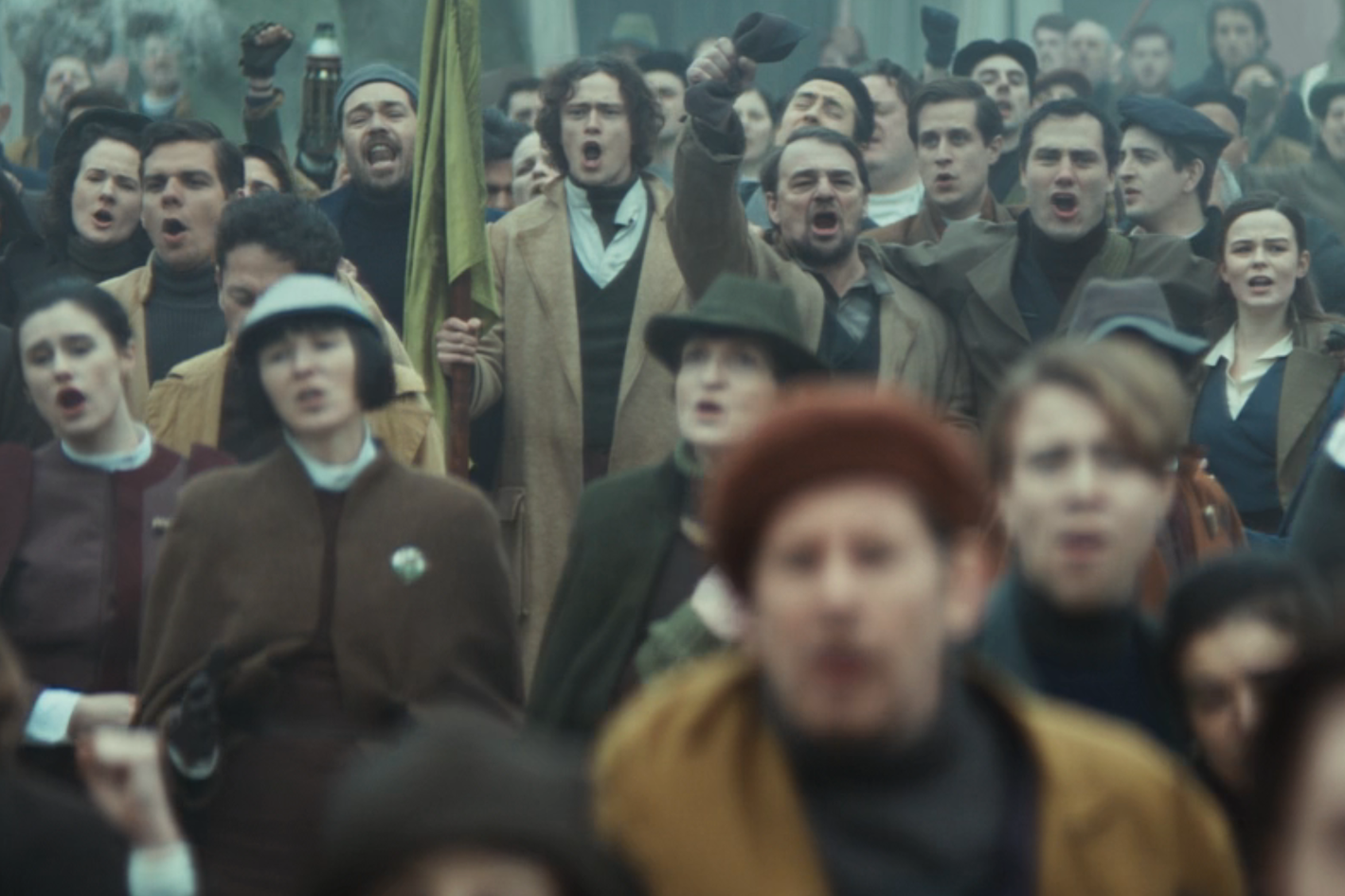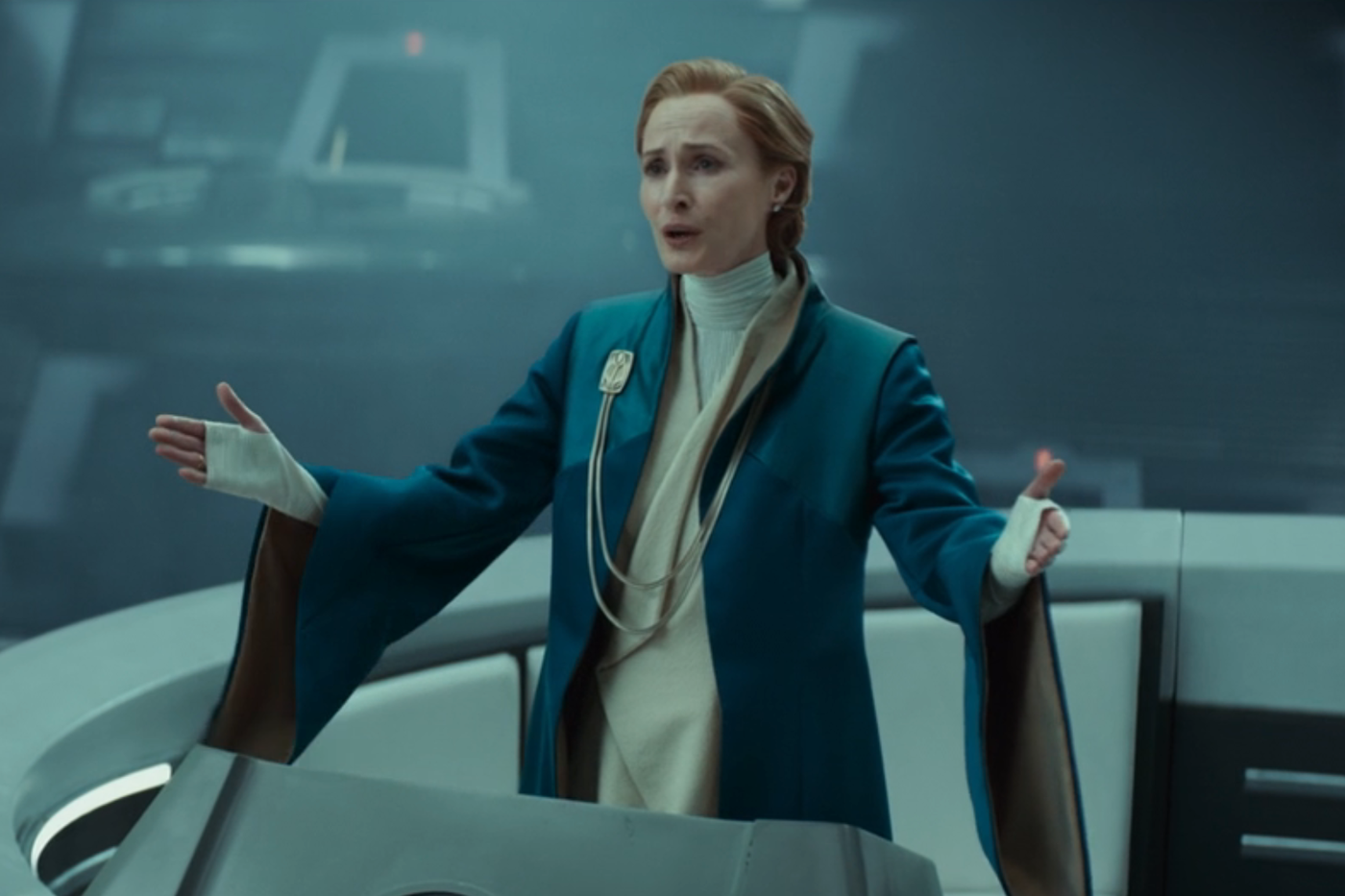

Spoilers follow for the first and second seasons of Andor, through season two’s ninth episode “Welcome to the Rebellion,” which premiered on Disney+ on May 6.
Only a child would claim that Star Wars isn’t political, which would be fine if we had all stayed children, the franchise’s original target audience. But Andor’s grown-up complexity lies in the boldness with which it draws connections between the evil Empire, the upstart Rebellion, and a multitude of real-world conflicts that align with that binary. The fact that the Empire’s massacre at Ghorman in season two’s “Who Are You?” elicits both the French Resistance to the Nazis during World War II and the Algerian revolution against the colonizing French in the 1950s and 1960s is a sign of writer Dan Gilroy’s awareness that every hero can be someone else’s villain. But the clear-eyed beauty of Andor is how it presents those who dare to make a fist against the “firm hand” holding them down as the ones we should be rooting for. Never before has Star Wars felt this insightful in its depiction of the multifaceted ways that oppressors oppress, or this urgent in its explanation of how that happens: propaganda and disinformation, bootlicking media and double-dealing politicians, xenophobic fervor and militaristic bloodlust. “Who Are You?” walks us through the imperialist playbook, and it is Andor at its best, not just in its presentation of the Empire as ruinous, deceitful, and cruel but also in its maddeningly timely — and timeless — depiction of how power consolidates by engineering powerlessness.
Andor’s Ghorman story line has been a powder keg lurking in the background as other Rebellion-related issues took the forefront: Mon Mothma’s banking woes, Bix’s myriad traumas, Saw Gerrera’s extremism. All the way back in “Aldhani,” the fourth episode of the first season, Mon chastises her crummy husband for throwing a dinner party when the Ghormans’ shipping lanes were “just cut off.” In sixth episode “The Eye,” she’s shocked by the Senate’s support for the Empire putting “a boot to the throats of all Ghormans, who’ve done nothing more than request their basic rights.” The Ghormans don’t appear onscreen in the first season, but Mon’s concern for them, juxtaposed with what we learn about how the Empire destroyed Aldhani’s Indigenous people and culture under the guise of “liberation,” suggests that Ghorman could eventually get treated the same way. Combined with Rebellion organizer Luthen Rael saying of the Aldhani heist that “the Empire has been choking us so slowly, we’re starting not to notice. The time has come to force their hand,” all of that sets up Andor’s second season to dive into Ghorman as a place where that force will come up again. (And thankfully not the Force, because Andor has largely stuck to its disinterest in Jedi-related matters.)
When Andor does land on Ghorman, the series goes into primer mode. We’re not seeing the aftermath of an Imperial takeover, like on Aldhani, we’re being told why the Empire wants Ghor: for energy purposes, including “gouge mining” a mineral named kalkite that will “transform the galactic economy and solidify Imperial authority,” according to Director Krennic. We’re also learning how that incursion will occur via the tools the Empire has at its disposal: A propaganda campaign to paint the Ghor as “putting themselves first” and brainwash people against the planet; a Senate vote to curtail even more of Ghorman’s rights, paving the way for an occupying Imperial force; Imperial Security Bureau officer Dedra infiltrating the Ghorman Front resistance group via her partner, Syril, who feeds them fake intel and bad guidance. In the year-plus that double-agent Syril is embedded within the Ghorman Front, he pushes them further into violent action — which the Empire’s media arm of course presents as more damaging than what the Empire itself is doing. Their campaign of misinformation then becomes a self-fulfilling loop: The Empire building an armory on Ghorman is necessary because the Ghor threat is so great; the Empire denigrating a Ghor memorial to unarmed protesters massacred by Grand Moff Tarkin is what this uppity planet deserves.
This is how public perception is manipulated to support the oppressor and disparage the oppressed, but the Empire isn’t happy with just widespread support for its misdeeds. It wants annihilation, and the Ghor’s refusal to bow to that bloodlust is what makes “Who Are You?” such an agonizing, moving watch. Even in a fishbowl, with all their exit doors locked and snipers on the rooftops, the Ghor don’t give in. And when the Empire fires the first shot at one of their own guards to make it look like the Ghor started the violence, Andor demonstrates how immorality is a by-product of power. The massacre is devastating to watch, which is exactly the point: There’s no way the Ghor can win against a force that has manufactured broad license to do whatever it wants. It’s all so evil that even Syril, once a willing cog in the machine, is aghast that Dedra turned him into an “outside agitator” just so the Empire could get its hands on Ghorman’s natural resources. (His little beret signals that he’s more aligned now with the Ghor and their struggle than Dedra ever could have expected.) And while Andor also wants us to recognize that some on the Rebellion’s side, like Luthen, see Ghorman as a necessary sacrifice to encourage other planets to rise up against the Empire, that acknowledgment feels less visceral than its clamoring insistence that this, all this, is happening now and has always happened.
Series creator Tony Gilroy is resistant to making direct comparisons between Andor and the real world: When asked about how season one’s Public Order Resentencing Directive seemed like the Empire’s version of the Patriot Act, and the torture of Ferrix rebels brought to mind Abu Ghraib and Guantánamo Bay, he said, “You could point at that, but there’s 3,000 years of recorded history too. You can go to the Montagnards, you can go to the Irgun, you can go to the African National Congress, you can go back to the Roman revolution … Watching revolutions come together and watching political factions within them, there’s a universal truth: There’s almost never just one forward motion. There are all kinds of people moving in different directions.” It’s Gilroy’s prerogative to reference whichever organizations or coalitions he wants, whether that’s the Indigenous people of Vietnam’s Central Highlands region (called “Montagnards” by the country’s French colonizers) who fought against the North Vietnamese or the Irgun, a Zionist paramilitary group responsible for killing hundreds of Arabs during World War II and terrorist attacks on British embassies and institutions. Nevertheless, it’s pretty clear that the Ghor are super French-coded (their language’s cadence, their peasant-style costuming, the Les Misérables flair of protestors bursting into song), and because of that, their uprising against the Empire could be read as an analogy to Nazi-occupied France.
The canniness of “Who Are You?,” though, is how many other movements it simultaneously evokes, and how it urges us to make connections between what’s happening to the Ghor in this fiction and what’s happened in our reality. Yes, Tarkin Massacre survivor and hotel bellhop Thela telling Cassian that “Rebellions are built on hope” is a tear-inducing little backstory for when Cassian says the same line in Rogue One: A Star Wars Story. But more compelling than that Easter egg is how “Who Are You?” pushes this kind of subjugation beyond the realm of galactic abstraction and grounds it in our own earthly reality. The Ghor’s “The galaxy is watching!” chant is a spin on “The whole world is watching” mantra first used during the civil-rights movement and anti–Vietnam War protests. The Empire’s outsize violence toward the mostly unarmed Ghor isn’t unlike U.S. police response to racial-justice demonstrations. And the shadow of the Israel-Hamas war that began in between the series’ two seasons, resulting in the leveling of Gaza and increased violence toward Palestinians in the West Bank, looms large over all of this.

Watching “Who Are You?,” the echoes between the Ghor and Palestinians become too loud to ignore: a sympathetic news media that prioritizes the occupier’s viewpoint; seizure of their lands for use by the military that’s already harassing them; an occupying force supporting a violent opposition group in order to weaken the occupied’s claim for self-governance; a massive body count attributable to the other side’s advanced weaponry. It’s impossible not to think about violence in Gaza and the West Bank during “Who Are You?” — or afterward, when in the following episode Mon describes what the Empire did to the Ghor as “genocide,” to angry protest in the Senate. But even if you were to put that parallel aside, this story line’s impact lies in its universality: Ghorman being plundered for its kalkite is also in line with the U.S. invasion of Iraq after 9/11 benefiting Big Oil, or Russia attacking Ukraine partially because of its natural resources, or recent intensifying violence in the Democratic Republic of the Congo over mining reserves that help fuel the world’s smartphones. The specific ways Andor depicts the devastation of Ghorman feel so familiar because they’re so diffuse and yet so constant.
As in our world, Mon’s use of the term “genocide” draws outrage, but Andor has so often positioned the Chandrilan leader as the Rebellion’s most reasonable voice that we can accept what she says here as the truth. And, well, we saw it: The Ghor were smeared, rounded up, trapped, murdered, then smeared again, a cycle that Andor examines step by step and that has relevance through decades of history until now. When Ghorman Front member and massacre survivor Dreena takes on the role of witness with her radio signal to the galaxy, pleading, “We are under siege. We are being slaughtered … Is there no one who can help us?,” her appeal joins a chorus of pained voices in the real world, one that Andor dares us to listen to.
Related

Latest News
For Sale! 2016 Sea Ray 350 Sundancer – $180,000
Reel Deal Yacht is pleased to feature a meticulously maintained 2016 Sea...
Trump’s Acceptance of Qatari Plane May Present National Security Risks: NPR
The Controversial Gift: Qatar’s Offer of a Luxury Aircraft to Trump On...
Struggling Sergio Garcia says he’d decline playing for European Ryder Cup team right now if invited
Sergio Garcia has appeared in 10 Ryder Cups and amassed more points...
Arsenal secures return to Champions League on day of farewells for Everton and Vardy
Arsenal has sealed its place in next season’s Champions League. Nottingham Forest...
The NBA’s final 4 is set: Thunder, Knicks, Wolves and Pacers remain, and parity reigns again
The parity era continues in the NBA. The New York Knicks haven’t...














Leave a comment